warning light MERCEDES-BENZ S-CLASS CABRIOLET 2018 Owner's Manual
[x] Cancel search | Manufacturer: MERCEDES-BENZ, Model Year: 2018, Model line: S-CLASS CABRIOLET, Model: MERCEDES-BENZ S-CLASS CABRIOLET 2018Pages: 502, PDF Size: 6.27 MB
Page 9 of 502
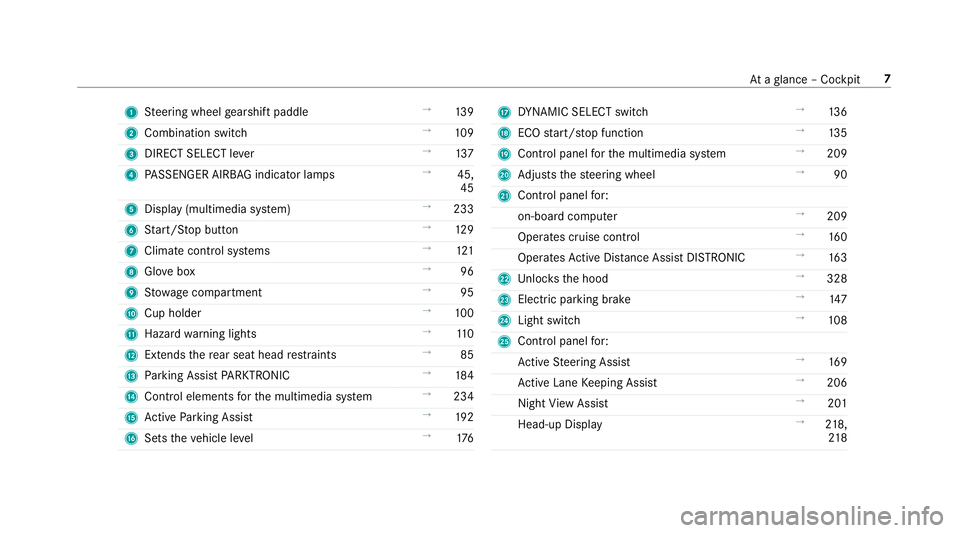
1Steering wheel gearshift paddle →
139
2 Combination switch →
109
3 DIRECT SELECT le ver →
137
4 PASSENGER AIRB AGindicator lamps →
45,
45
5 Display (multimedia sy stem) →
233
6 Start/ Stop button →
129
7 Climat e control sy stems →
121
8 Glovebox →
96
9 Stow age compartment →
95
A Cup holder →
100
B Hazard warning lights →
110
C Extends there ar seat head restra ints →
85
D Parking Assist PARKTRONI C →
184
E Control elements forth e multimedia sy stem →
234
F Active Parking Assist →
192
G Sets theve hicle le vel →
176H
DYNA MIC SELECT switch →
136
I ECO start/ stop function →
135
J Control panel forth e multimedia sy stem →
209
K Adjusts thesteering wheel →
90
L Control panel for:
on-board computer →
209
Operates cruise contro l →
160
Operates Active Dis tance Assist DISTRONIC →
163
M Unloc ksthe hood →
328
N Elect ric park ing brake →
147
O Light switch →
108
P Control panel for:
Ac tive Steering Assist →
169
Ac tive Lane Keeping Assist →
206
Night View Assist →
201
Head-up Display →
218,
21 8
At aglance – Cockpit 7
Page 13 of 502
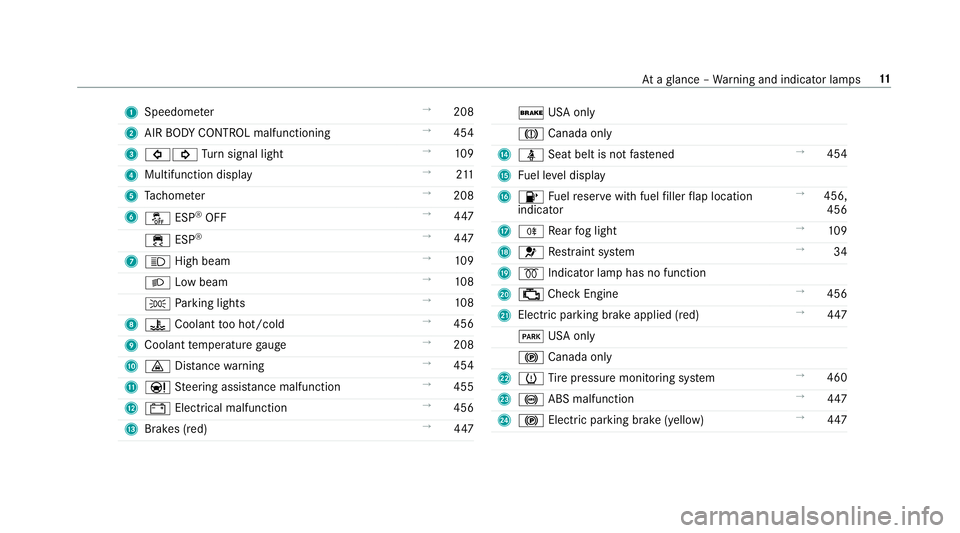
1Speedom eter →
208
2 AIR BODY CONTROL malfunctioning →
454
3 #! Turn signal light →
109
4 Multifunction display →
211
5 Tach ome ter →
208
6 å ESP
®OFF →
447
÷ ESP
®→
447
7 K High beam →
109
L Low beam →
108
T Parking lights →
108
8 ? Coolant too hot/cold →
456
9 Coolant temp erature gauge →
208
A · Distance warning →
454
B Ð Steering assis tance malfunction →
455
C # Electrical malfunction →
456
D Brakes (red) →
447
$ USA only
J Canada only
E ü Seat belt is not fastened →
454
F Fuel le vel display
G 8 Fuelreser vewith fuel filler flap location
indicator →
456,
456
H R Rear fog light →
109
I 6 Restra int sy stem →
34
J % Indicator lamp has no function
K ; Check Engine →
456
L Elect ric park ing brake applied (red) →
447
F USA only
! Canada only
M h Tire pressure monitoring sy stem →
460
N ! ABS malfunction →
447
O ! Electric pa rking brake (yellow) →
447
At aglance – Warning and indicator lamps 11
Page 22 of 502
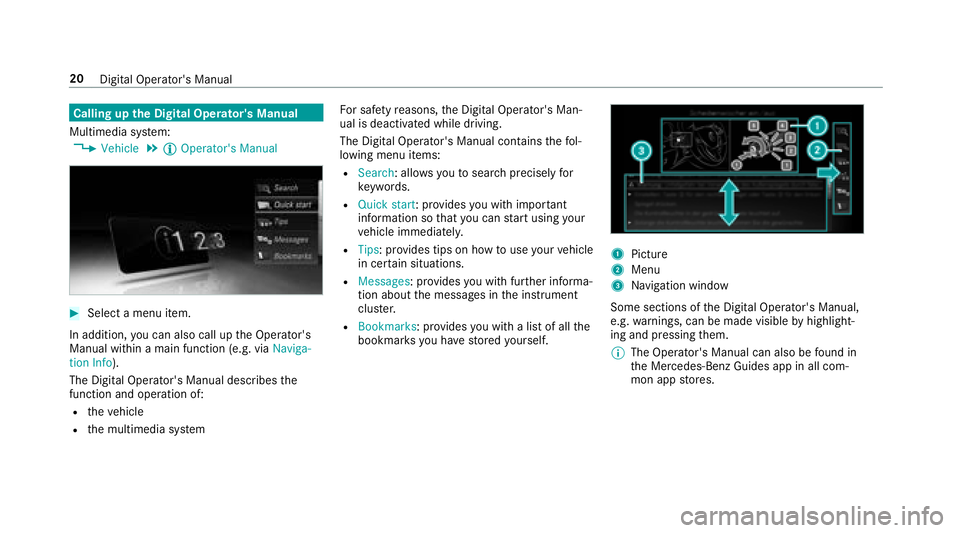
Calling upthe Digital Operator's Manual
Multimedia sy stem:
,Vehicle.Õ Operator's Manual
#Select a menu item.
In addition, you can also call up the Operator's
Manual within a main function (e.g. via Naviga-
tion Info).
The Digital Operator's Manual describes the
function and operation of:
Rth eve hicle
Rthe multimedia sy stem Fo
r saf etyre asons, the Digital Operator's Man‐
ual is deactivated while driving.
The Digital Operator's Manual conta insthefo l‐
lowing menu items:
RSearch: allo wsyouto sear chprecisely for
ke ywords.
RQuic kstart: prov ides youwit him por tant
information so that you can start using your
ve hicle immediately.
RTips: pr ovides tips on how touse your vehicle
in cer tain situations.
RMessages : provides youwit h fur ther informa‐
tion about the messages in the instrument
clus ter.
RBookmarks : provides you with a list of all the
bookmar ksyou ha vestored yourself.
1Picture
2Menu
3Na vigation window
Some sections of the Digital Operator's Manual,
e.g. warnings, can be made visible byhighlight‐
ing and pressing them.
% The Operator's Manual can also be found in
th e Mercedes-Benz Guides app in all com‐
mon app stores.
20
Digital Operator's Manual
Page 36 of 502
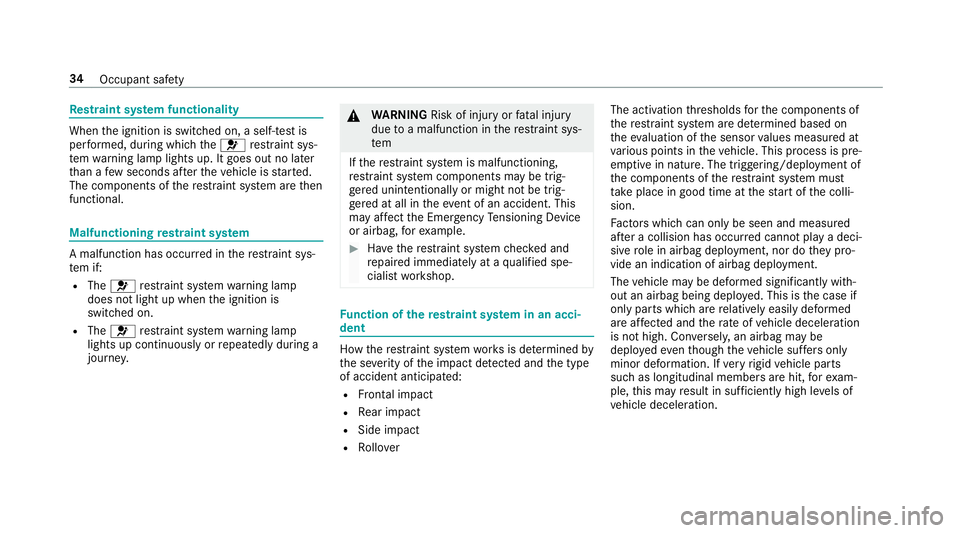
Restra int sy stem functionality
When the ignition is switched on, a self-test is
per form ed, during which the6 restra int sys‐
te m wa rning lamp lights up. It goes out no later
th an a few seconds af terth eve hicle is star ted.
The components of there stra int sy stem are then
functional.
Malfunctioning restra int sy stem
A malfunction has occur red in there stra int sys‐
te m if:
RThe 6 restra int sy stem warning lamp
does not light up when the ignition is
switched on.
RThe 6 restra int sy stem warning lamp
lights up continuously or repeatedly during a
journe y.
&
WARNING Risk of injury orfata l injury
due toa malfunction in there stra int sys‐
te m
If th ere stra int sy stem is malfunctioning,
re stra int sy stem components may be trig‐
ge red unintentionally or might not be trig‐
ge red at all in theeve nt of an accident. This
may af fect the Emer gency Tensioning Device
or airbag, forex ample.
#Ha ve there stra int sy stem checked and
re paired immediately at a qualified spe‐
cialist workshop.
Fu nction of there stra int sy stem in an acci‐
dent
How there stra int sy stem works is de term ined by
th e se verity of the impact de tected and the type
of accident anticipated:
RFr ontal impact
RRe ar impact
RSide impact
RRo llover The activation
thre sholds forth e components of
th ere stra int sy stem are de term ined based on
th eev aluation of the sensor values measured at
va rious points in theve hicle. This process is pre-
em ptive in nature. The triggering/deployment of
th e components of there stra int sy stem must
ta ke place in good time at thest art of the colli‐
sion.
Fa ctors whi chcan only be seen and measure d
af te r a collision has occur red cann otplay a deci‐
sive role in airbag deployment, nor do they pro‐
vide an indication of airbag deployment.
The vehicle may be deformed significantly with‐
out an airbag being deplo yed. This is the case if
only parts which are relatively easily deformed
are af fected and thera te ofvehicle deceleration
is not high. Con versely, an airbag may be
deplo yedev en though theve hicle suf fers only
minor deformation. If very rigid vehicle parts
such as longitudinal members are hit, forex am‐
ple, this may result in suf ficiently high le vels of
ve hicle deceleration.
34
Occupant saf ety
Page 42 of 502
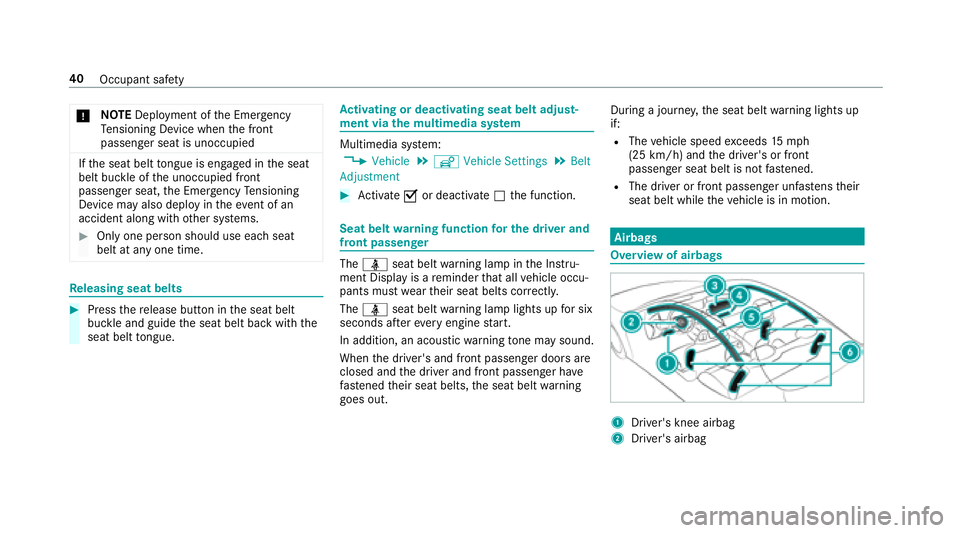
*NO
TEDeployment of the Emer gency
Te nsioning Device when the front
passenger seat is unoccupied
If th e seat belt tongue is engaged in the seat
belt buckle of the unoccupied front
passenger seat, the Emer gency Tensioning
Device may also depl oyintheev ent of an
accident along with other sy stems.
#Only one person should use each seat
belt at any one time.
Re leasing seat belts
#Press there lease button in the seat belt
buckle and guide the seat belt back with the
seat belt tongue.
Ac tivating or deactivating seat belt adjust‐
ment via the multimedia sy stem
Multimedia sy stem:
,Vehicle.î Vehicle Settings.Belt
Adjustment
#Ac tivate Oor deacti vate ª the function.
Seat belt warning function for the driver and
front passen ger
The ü seat belt warning lamp in the Instru‐
ment Display is a reminder that all vehicle occu‐
pants must weartheir seat belts cor rectly.
The ü seat belt warning lamp lights up for six
seconds af tereve ryengine start.
In addition, an acoustic warning tone may sound.
When the driver's and front passenger doors are
closed and the driver and front passenger ha ve
fast ened their seat belts, the seat belt warning
goes out. During a journe
y,the seat belt warning lights up
if:
RThe vehicle speed exceeds 15mp h
(25 km/h) and the driver's or front
passenger seat belt is not fastened.
RThe driver or front passenger unfas tens their
seat belt while theve hicle is in motion.
Airbags
Overview of airbags
1Driver's knee airbag
2Driver's airbag
40
Occupant saf ety
Page 47 of 502
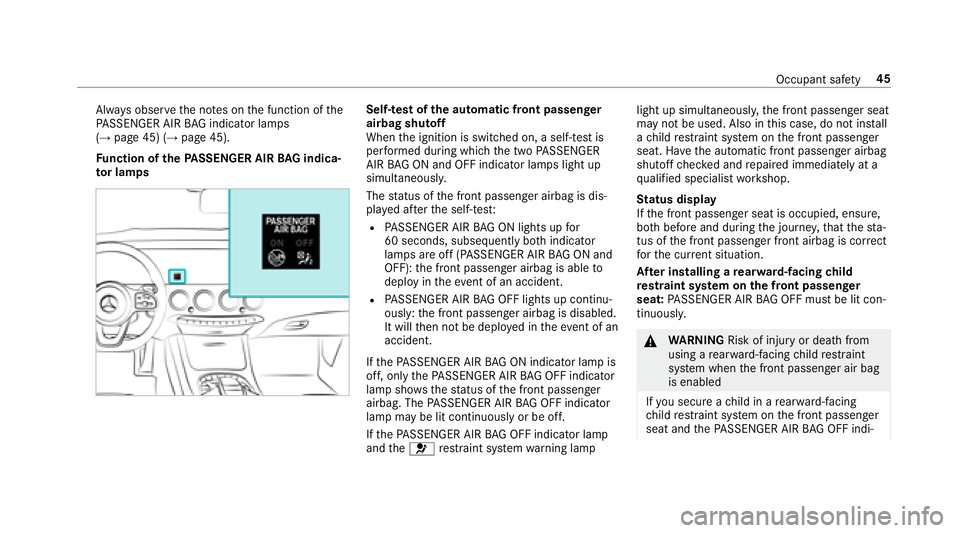
Always obser vethe no tes on the function of the
PA SSENGER AIR BAG indicator lamps
(
→page 45) (→page 45).
Fu nction of thePA SSENGER AIR BAG indica‐
to r lamps
Self- test of the automatic front passenger
airbag shuto ff
When the ignition is switched on, a self-test is
per form ed during which the two PASSENGER
AIR BAG ON and OFF indicator lamps light up
simul taneously.
The status of the front passenger airbag is dis‐
pla yed af terth e self-tes t:
RPASSENGER AIR BAG ON lights up for
60 seconds, subsequently bo thindicator
lamps are off (PASSENGER AIR BAG ON and
OFF): the front passenger airbag is able to
deploy in theev ent of an accident.
RPA SSENGER AIR BAG OFF lights up continu‐
ously: the front passenger airbag is disabled.
It will then not be deplo yed in theeve nt of an
accident.
If th ePA SSENGER AIR BAG ON indicator lamp is
off, only thePA SSENGER AIR BAG OFF indicator
lamp sho wsthest atus of the front passenger
airbag. The PASSENGER AIR BAG OFF indicator
lamp may be lit continuously or be off.
If th ePA SSENGER AIR BAG OFF indicator lamp
and the6 restra int sy stem warning lamp light up simultaneousl
y,the front passenger seat
may not be used. Also in this case, do not ins tall
a ch ild restra int sy stem on the front passenger
seat. Ha vethe automatic front passenger airbag
shutoff checked and repaired immediately at a
qu alified specialist workshop.
St atus display
If th e front passenger seat is occupied, ensure,
bo th bef ore an
d during
the journe y,that thest a‐
tus of the front passenger front airbag is cor rect
fo rth e cur rent situation.
Af ter in stalling a rear wa rd-facing child
re stra int sy stem on the front passenger
seat: PASSENGER AIR BAG OFF must be lit con‐
tinuousl y.
&
WARNING Risk of injury or death from
using a rear wa rd-facing child restra int
sy stem when the front passenger air bag
is enabled
If yo u secure a child in a rear wa rd-f acing
ch ild restra int sy stem on the front passenger
seat and thePA SSENGER AIR BAG OFF indi‐
Occupant saf ety 45
Page 49 of 502
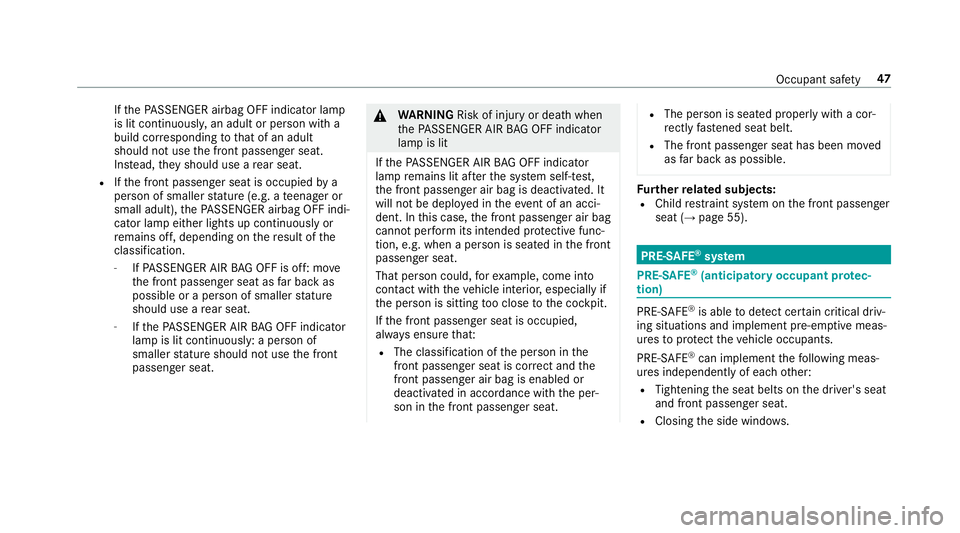
Ifth ePA SSENGER airbag OFF indica tor lamp
is lit continuously, an adult or person with a
build cor responding tothat of an adult
should not use the front passenger seat.
Ins tead, they should use a rear seat.
RIfth e front passenger seat is occupied bya
person of smaller stature (e.g. a teenager or
small adult), thePA SSENGER airbag OFF indi‐
cator la mpeither lights up continuously or
re mains off, depending on there sult of the
classifi cation.
-IfPA SSENGER AIR BAG OFF is off: mo ve
th e front passenger seat as far back as
possible or a person of smaller stature
should use a rear seat.
-Ifth ePA SSENGER AIR BAG OFF indicator
lamp is lit continuously: a person of
smaller stature should not use the front
passenger seat.
& WARNING Risk of injury or death when
th ePA SSENGER AIR BAG OFF indicator
lamp is lit
If th ePA SSENGER AIR BAG OFF indicator
lamp remains lit af terth e sy stem self-test,
th e front passenger air bag is deactivated. It
will not be deplo yed in theeve nt of an acci‐
dent. In this case, the front passenger air bag
cannot perform its intended pr otective func‐
tion, e.g. when a person is seated in the front
passenger seat.
That person could, forex ample, come into
con tact wi th theve hicle interior, especially if
th e person is sitting too close tothe cockpit.
If th e front passenger seat is occupied,
alw ays ensure that:
RThe classification of the person in the
front passenger seat is cor rect and the
front passenger air bag is enabled or
deactivated in accordance with the per‐
son in the front passenger seat.
RThe person is seated proper lywith a cor‐
re ctly fastened seat belt.
RThe front passenger seat has been mo ved
as far back as possible.
Fu rther related subjects:RChild restra int sy stem on the front passenger
seat (→page 55).
PRE-SAFE®sy stem
PRE- SAFE®(anticipa tory occupant pr otec‐
tion)
PRE- SAFE®is able todetect cer tain critical driv‐
ing situations and implement pre-em ptive meas‐
ures toprotect theve hicle occupants.
PRE-SAFE
®can implement thefo llowing meas‐
ures independently of each other:
RTightening the seat belts on the driver's seat
and front passenger seat.
RClosing the side windo ws.
Occupant saf ety 47
Page 51 of 502
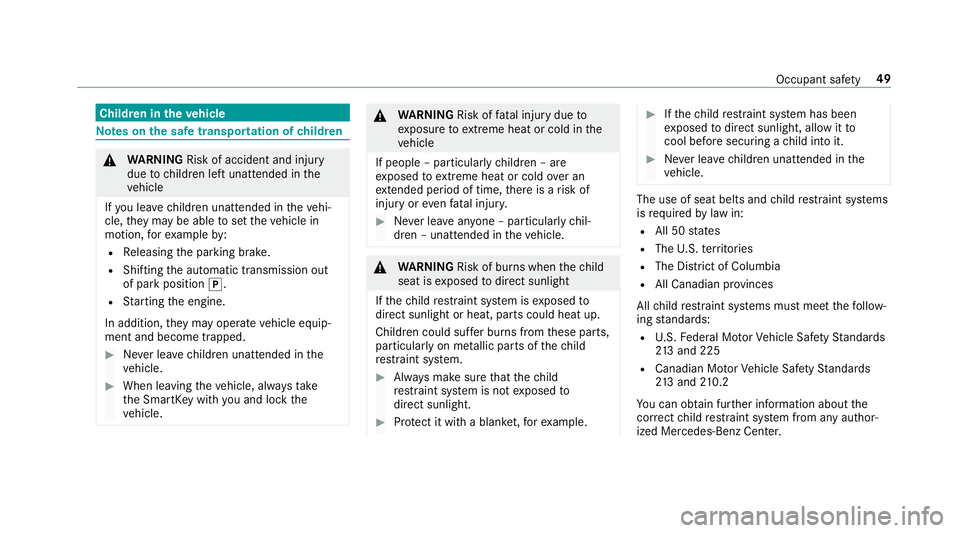
Children in theve hicle
Note s onthe safe transportation of children
&
WARNING Risk of accident and injury
due tochildren left unatte nded inthe
ve hicle
If yo u lea vechildren unatte nded intheve hi‐
cle, they may be able toset theve hicle in
motion, forex ample by:
RRe leasing the parking brake.
RShifting the automatic transmission out
of park position j.
RStarting the engine.
In addition, they may operate vehicle equip‐
ment and become trapped.
#Ne ver lea vechildren unatte nded inthe
ve hicle.
#When leaving theve hicle, alw aysta ke
th e SmartK eywith you and lock the
ve hicle.
&
WARNING Risk offata l injury due to
ex posure toextreme heat or cold in the
ve hicle
If people – particularly children – are
ex posed toextreme heat or cold over an
ex tended pe riod of time, there is a risk of
injury or evenfa ta l injur y.
#Never lea veanyone – pa rticularly chil‐
dren – unatte nded intheve hicle.
&
WARNING Risk of burn s whenthech ild
seat is exposed todirect sunlight
If th ech ild restra int sy stem is exposed to
direct sunlight or heat, parts could heat up.
Children could suf fer burns from these parts,
particularly on me tallic parts of thech ild
re stra int sy stem.
#Alw ays make sure that thech ild
re stra int sy stem is not exposed to
direct sunlight.
#Pr otect it with a blank et,fo rex ample.
#Ifth ech ild restra int sy stem has been
ex posed todirect sunlight, allow it to
cool before securi ng achild into it.
#Ne ver lea vechildren unatte nded inthe
ve hicle.
The use of seat belts and child restra int sy stems
is requ ired bylaw in:
RAll 50 states
RThe U.S. territories
RThe District of Columbia
RAll Canadian pr ovinces
All child restra int sy stems must meet thefo llow‐
ing standards:
RU. S. Federal Mo torVe hicle Saf etySt andards
21 3 and 225
RCanadian Mo torVe hicle Saf etySt andards
21 3 and 210.2
Yo u can obtain fur ther information about the
cor rect child restra int sy stem from any author‐
ized Mercedes-Benz Center.
Occupant saf ety 49
Page 70 of 502
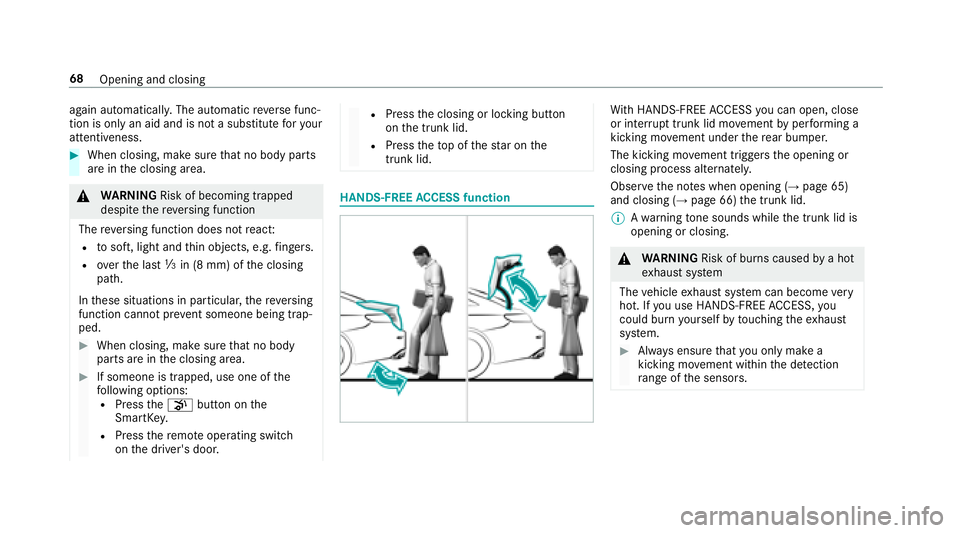
again automatically.The automatic reve rse func‐
tion is only an aid and is not a substitute foryo ur
attentiveness.
#When closing, make sure that no body parts
are in the closing area.
&
WARNING Risk of becoming trapped
despite there ve rsing function
The reve rsing function does not react:
Rto soft, light and thin objects, e.g. fingers.
Rove rth e last Óin (8 mm) of the closing
path.
In these situations in particular, there ve rsing
function cannot pr event someone being trap‐
ped.
#When closing, make surethat no body
parts are in the closing area.
#If someone is trapped, use one of the
fo llowing options:
RPress thep button on the
SmartK ey.
RPress there mo teoperating switch
on the driver's door.
RPress the closing or locking button
on the trunk lid.
RPress theto p of thest ar on the
trunk lid.
HANDS-FREE ACCESS function
With HANDS-FREE ACCESS you can open, close
or inter rupt trunk lid mo vement byper form ing a
kicking mo vement under there ar bumper.
The kicking mo vement triggers the opening or
closing process alternately.
Obser vethe no tes when opening (
→page 65)
and closing (→page 66) the trunk lid.
% Awa rning tone sounds while the trunk lid is
opening or closing.
& WARNING Risk of burn s causedbya hot
ex haust sy stem
The vehicle exhaust sy stem can become very
hot. If you use HANDS- FREEACCESS, you
could burn yourself by touching theex haust
sy stem.
#Alw ays ensure that you only ma kea
kicking mo vement within the de tection
ra nge of the sensors.
68
Opening and closing
Page 75 of 502
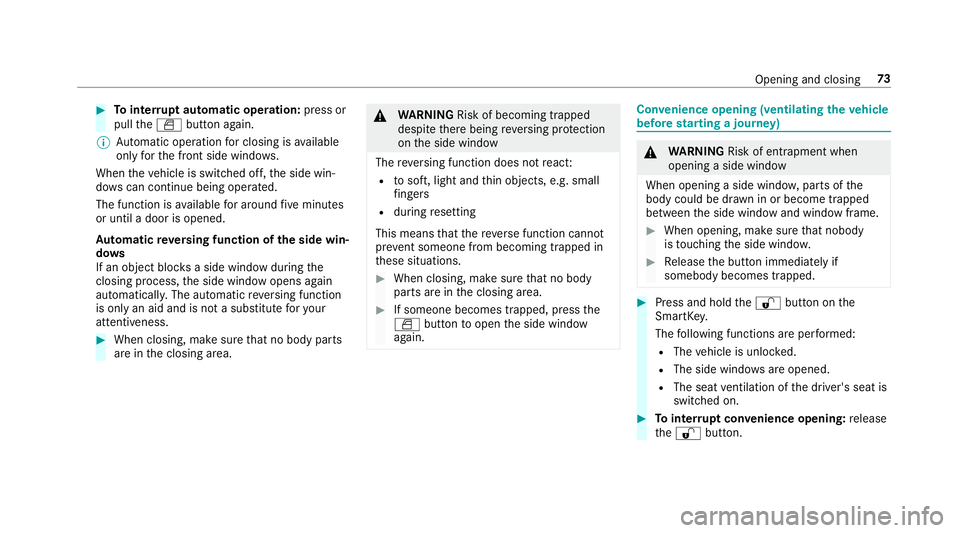
#Tointer rupt automatic operation: press or
pull theW button again.
% Automatic operation for closing is available
only forth e front side windo ws.
When theve hicle is switched off, the side win‐
do ws can continue being ope rated.
The function is available for around five minutes
or until a door is opened.
Au tomatic reve rsing function of the side win‐
do ws
If an object bloc ksa side wind owduring the
closing process, the side window opens again
automaticall y.The automatic reve rsing function
is only an aid and is not a substitute foryo ur
attentiveness.
#When closing, make sure that no body parts
are in the closing area.
&
WARNING Risk of becoming trapped
despite there being reve rsing pr otection
on the side window
The reve rsing function does not react:
Rto soft, light and thin objects, e.g. small
fi ngers
Rdu ring resetting
This means that there ve rse function cannot
pr eve nt someone from becoming trapped in
th ese situations.
#When closing, make sure that no body
parts are in the closing area.
#If someone becomes trapped, press the
W button toopen the side window
again.
Con venience opening (ventilating theve hicle
before starting a journey)
&
WARNING Risk of entrapment when
opening a side window
When opening a side windo w,parts of the
body could be dr awn in or become trapped
between the side window and window frame.
#When opening, make sure that nobody
is touching the side windo w.
#Release the button immediately if
somebody becomes trapped.
#Press and hold the% button on the
SmartK ey.
The following functions are per form ed:
RThe vehicle is unloc ked.
RThe side windo wsare opened.
RThe seat ventilation of the driver's seat is
switched on.
#To inter rupt convenience opening: release
th e% button.
Opening and closing 73